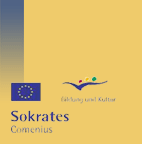|
Preparation:
Compasses, magnets, a bowl,
a piece of cork, a needle or metal bar, tape.
|
Steps:
The nursery school teacher
has a compass for each pair of children. At first the children
can experiment freely with
the compass. The nursery school teacher mentions the directions, and
afterwards the children think about in which direction the needle of the
compass points and may experiment further. The children guess why the needle
turns. They take a magnet and
experiment further, the
magnets poles are labelled.
Building the compass: The
necessary materials are put into the
centre of the circle. The
children describe the materials and think about
how they can build a compass
from the materials. With the help of the
nursery school teacher the
children build a compass.
Building instructions:
- In order to magnetise the needle you rub
it on a magnet for approximately 15 seconds.
- You use the tape to stick the needle onto
the piece of cork.
- Now you let the cork float in the bowl
filled with water.
4. The
North Pole of the needle always points to the North.
The children try the
compass and pairs are asked to build their own compass. They take another
compass as a model. The nursery school teacher makes the connection with the
North and South Poles of
the earth.
Note: With these materials the children may also
experiment in free play.
|











